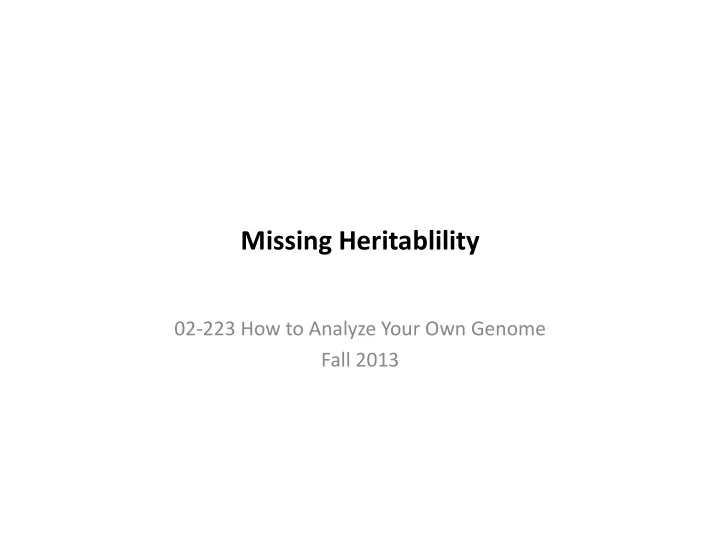

Missing ¡Heritablility ¡ 02-‑223 ¡How ¡to ¡Analyze ¡Your ¡Own ¡Genome ¡ Fall ¡2013 ¡
Heritability ¡ • Heritability: ¡the ¡propor>on ¡of ¡observed ¡varia>on ¡in ¡a ¡ par>cular ¡trait ¡(as ¡height) ¡that ¡can ¡be ¡aGributed ¡to ¡inherited ¡ gene>c ¡factors ¡in ¡contrast ¡to ¡environmental ¡ones ¡
Heritability ¡ • Heritability ¡can ¡be ¡es>mated ¡from ¡the ¡regression ¡of ¡offspring ¡ phenotypic ¡values ¡on ¡the ¡average ¡of ¡parental ¡phenotypic ¡ values ¡
Missing ¡Heritability ¡ • Height ¡is ¡80-‑90% ¡heritable ¡ • Using ¡a ¡single ¡SNP ¡analysis ¡ – In ¡GWAS ¡over ¡30,000 ¡people, ¡more ¡than ¡40 ¡loci ¡were ¡found ¡to ¡be ¡ associated ¡with ¡the ¡height ¡ – Only ¡5% ¡of ¡the ¡height’s ¡heritability ¡is ¡explained ¡by ¡the ¡gene>c ¡ varia>on ¡at ¡those ¡40 ¡loci ¡ • Analyzing ¡all ¡SNPs ¡jointly ¡for ¡their ¡influence ¡on ¡height ¡ – 45% ¡of ¡the ¡height’s ¡heritability ¡is ¡explained ¡by ¡SNPs ¡ • How ¡can ¡we ¡explain ¡the ¡missing ¡heritability? ¡
Missing ¡Heritability ¡ • Studies ¡looking ¡at ¡similari>es ¡between ¡iden>cal ¡and ¡fraternal ¡ twins ¡es>mate ¡heritability ¡at ¡more ¡than ¡90% ¡for ¡au>sm ¡and ¡ more ¡than ¡80% ¡for ¡schizophrenia ¡ • O[en, ¡the ¡gene>c ¡loci ¡found ¡by ¡GWAS ¡explain ¡a ¡small ¡frac>on ¡ ¡ of ¡the ¡heritability ¡
Explaining ¡Missing ¡Heritability ¡ • Undetected ¡epistasis ¡ • Going ¡beyond ¡SNPs ¡ – Structural ¡variants: ¡inser>ons, ¡dele>ons, ¡duplica>on, ¡copy ¡number ¡variants ¡ • Heritability ¡es>mate ¡could ¡be ¡wrong. ¡Environment ¡(e.g., ¡diet) ¡can ¡be ¡ heritable ¡within ¡families ¡ • Epigene>cs ¡changes ¡in ¡gene ¡expression ¡that ¡are ¡inherited ¡but ¡not ¡caused ¡ by ¡changes ¡in ¡gene>c ¡sequence ¡ – Feeding ¡a ¡mouse ¡a ¡certain ¡diet, ¡for ¡example, ¡can ¡alter ¡the ¡coat ¡color ¡not ¡only ¡in ¡its ¡ children, ¡but ¡also ¡in ¡its ¡children’s ¡children. ¡Here, ¡the ¡expression ¡of ¡a ¡coat-‑color ¡ gene ¡is ¡controlled ¡by ¡a ¡type ¡of ¡DNA ¡modifica>on ¡(epigene>c ¡modifica>on) ¡called ¡ methyla>on. ¡ • From ¡common ¡variants ¡to ¡rare ¡variants ¡
Common ¡Variants ¡vs. ¡Rare ¡Variants ¡ • First-‑genera>on ¡genome-‑wide ¡associa>on ¡study ¡(GWAS): ¡common ¡variant ¡ common ¡disease ¡hypothesis ¡ • Common ¡low-‑penetrance ¡variants ¡ ¡ ¡ ¡ ¡(Penetrance: ¡the ¡likelihood ¡that ¡the ¡causal ¡loci ¡will ¡in ¡fact ¡have ¡an ¡effect ¡ on ¡the ¡phenotype) ¡ • Common ¡variants ¡with ¡minor ¡allele ¡frequency ¡(MAF)>5% ¡ – dbGap: ¡~11 ¡million ¡SNPs ¡ – HapMap: ¡3.5 ¡million ¡SNPs ¡ – A ¡successful ¡GWAS ¡requires ¡a ¡more ¡complete ¡catalogue ¡of ¡gene>c ¡varia>ons ¡ • Rare ¡variants ¡(MAF<0.5%), ¡low-‑frequency ¡variants ¡(MAF:0.5%~5%) ¡ – Captured ¡by ¡sequencing ¡with ¡next-‑genera>on ¡sequencing ¡technology ¡ – Rare, ¡moderately ¡penetrant ¡alleles ¡ – Possibly ¡significant ¡contributors ¡to ¡the ¡gene>c ¡architecture ¡of ¡disease ¡ • Causal ¡variants ¡are ¡subject ¡to ¡nega>ve ¡selec>on ¡
1000 ¡Genome ¡Project ¡ (The ¡1000 ¡Genome ¡Project ¡ConsorBum, ¡Nature ¡2010) ¡ ¡ ¡ The ¡ goal ¡ is ¡ to ¡ characterize ¡ over ¡ 95% ¡ of ¡ variants ¡ that ¡ are ¡ in ¡ genomic ¡ regions ¡ accessible ¡ to ¡ current ¡ high-‑throughput ¡ sequencing ¡ technologies ¡ and ¡ that ¡ have ¡ allele ¡frequency ¡of ¡1% ¡or ¡higher ¡ (the ¡classical ¡defini>on ¡of ¡polymorphism) ¡in ¡each ¡ of ¡ five ¡major ¡populaBon ¡groups ¡ (popula>ons ¡in ¡or ¡with ¡ancestry ¡from ¡Europe, ¡East ¡ Asia, ¡South ¡Asia, ¡West ¡Africa ¡and ¡the ¡Americas) ¡ ¡ ¡ ¡ -‑ ¡ ¡179 ¡individuals ¡(low ¡coverage) ¡ ¡ ¡ ¡ -‑ ¡ ¡6 ¡individuals ¡in ¡two ¡trios ¡(deep ¡sequencing) ¡ ¡ ¡ ¡ -‑ ¡ ¡697 ¡individuals ¡(exon ¡sequencing ¡of ¡8,140 ¡exons) ¡
1000 ¡Genome ¡Projects: ¡ ¡ Known ¡vs. ¡Novel ¡Variants ¡
AssociaBons ¡to ¡Rare ¡Variants ¡ • O[en ¡GWA ¡studies ¡are ¡underpowered ¡for ¡func>onal ¡rare ¡ variants ¡ Common ¡Variant ¡Associa>on ¡ Rare ¡Variant ¡Associa>on ¡ Case ¡ Control ¡ Case ¡ Control ¡ Allele ¡a ¡ 60 ¡ 20 ¡ Allele ¡a ¡ 7 ¡ 2 ¡ Allele ¡A ¡ 40 ¡ 80 ¡ Allele ¡A ¡ 93 ¡ 98 ¡ • Common ¡variant ¡GWA ¡approaches ¡are ¡appropriate ¡only ¡for ¡ common ¡variants ¡
Recent ¡Methods ¡for ¡DetecBng ¡Rare ¡Variant ¡ AssociaBons ¡ • Test ¡combined ¡effect ¡of ¡mul>ple ¡rare ¡variants ¡ • Fixed-‑Threshold ¡Approach ¡ (Li ¡& ¡Leal, ¡AJHG ¡2008) ¡ – Include ¡only ¡the ¡SNPs ¡with ¡allele ¡frequency ¡below ¡a ¡fixed ¡threshold ¡ – For ¡SNP ¡ i=1,…,m ¡in ¡a ¡genomic ¡region ¡or ¡a ¡gene, ¡ m ∑ C ε Score = i i i = 1 » ¡ ¡ ¡ ¡ ¡ ¡ ¡ ¡: ¡The ¡allele ¡frequency ¡of ¡SNP ¡ i ¡in ¡cases ¡ C i ⎧ ε = 1 If ¡the ¡allele ¡frequency ¡of ¡SNP ¡ i ¡is ¡below ¡a ¡specified ¡threshold ¡ ⎨ » ¡ ¡ ¡ ¡ ¡ ¡ ¡ i Otherwise ¡ 0 ⎩ – Evaluate ¡the ¡significance ¡of ¡ Score ¡
Feasibility ¡of ¡IdenBfying ¡Disease ¡Loci ¡
Summary ¡ • Missing ¡heritability: ¡GWAS ¡had ¡only ¡limited ¡success ¡ • 1000 ¡Genome ¡Project ¡for ¡obtaining ¡a ¡more ¡complete ¡ catalogue ¡of ¡gene>c ¡varia>ons ¡in ¡human ¡genomes ¡ • Post ¡GWAS ¡ – Rare ¡variants ¡ – Epigene>c ¡varia>on ¡ – Structural ¡varia>on ¡
Recommend
More recommend